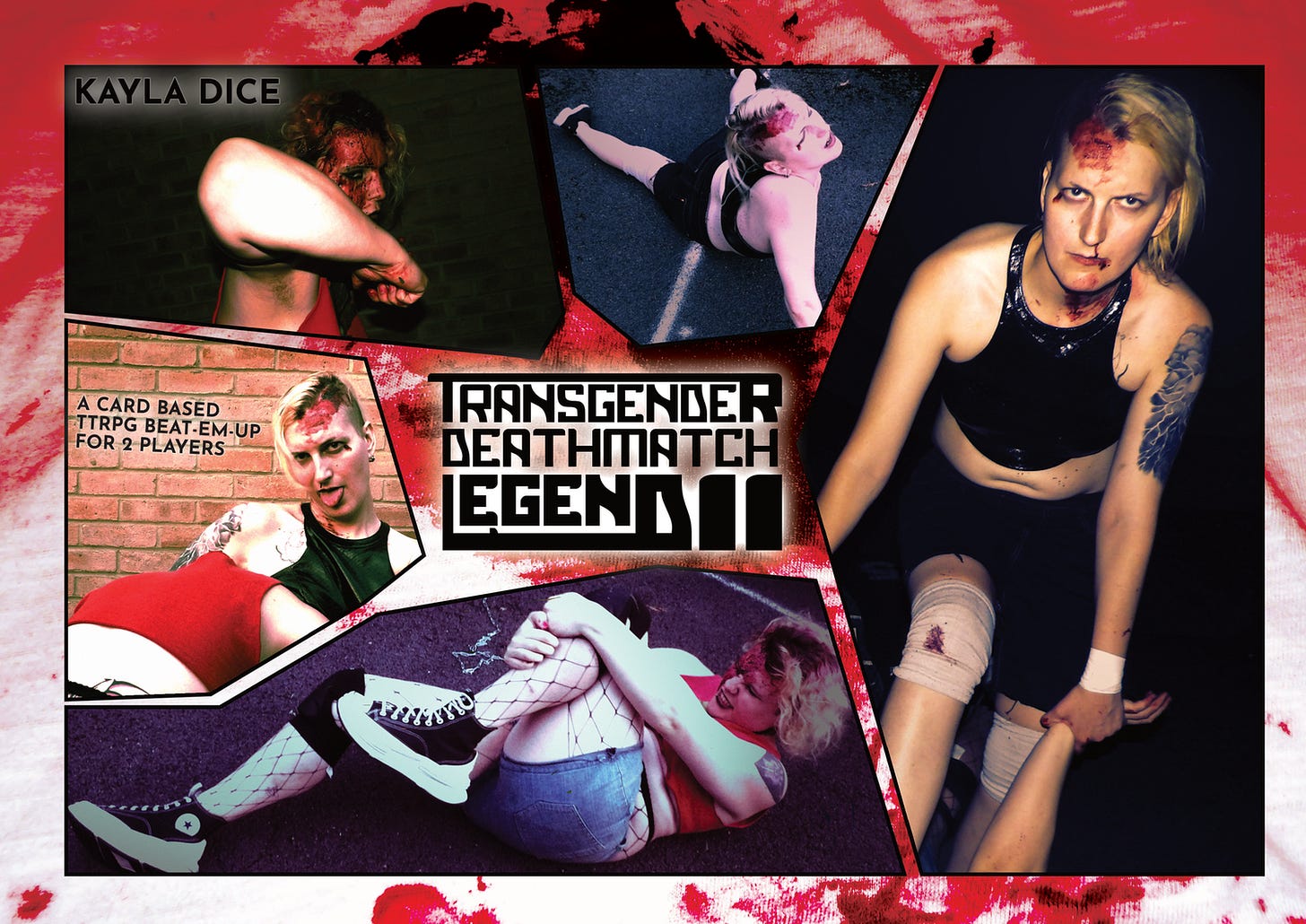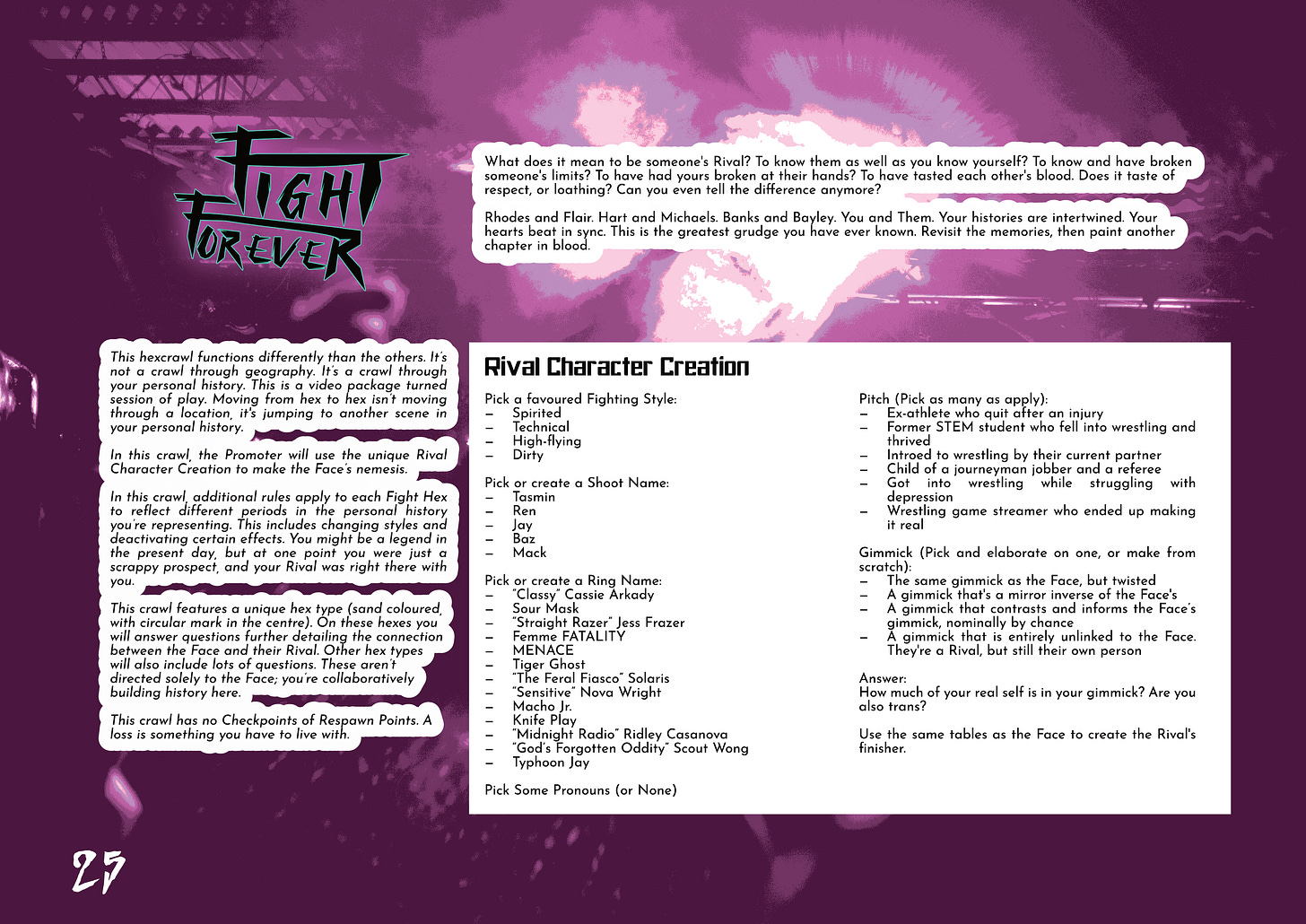The Last Level (Fight Forever Commentary)
Plus: Nemesis Retribution in print and Transgender Deathmatch Legend II out digitally
Hello and welcome back to the new style Rat Wave Newsletter. This month’s blog post is a commentary on Fight Forever, the final scenario from Transgender Deathmatch Legend II. Some quick news bits before that though.
I’ve done a small print run of Nemesis Retribution. Currently it’s only available through the BackerKit hosted pre-orders for TDL2. Speaking of which TDL2 has gone to print and been released digitally (hence the design deep dive to celebrate). Fulfilment will kick off in earnest this month, after that’s done I’ll be diving back into development for Strangers in the Vast Dark.
The Last Level
After the campaign ended for Transgender Deathmatch Legend II I didn't touch the project for about a month. I was waiting for the edit before I moved into layout, as well as being busy with a month of conventions and Christmas plans. I'd had a gap between the campaign end and layout start for PSYCHODUNGEON too, in that case it actually meant I felt I'd put my feelings about the campaign behind me and doing layout re-energised how I felt about the game. This time my feelings lingered, and for a while in the process I found it difficult to see how I felt about the game, all I could see is what I thought went wrong with the campaign.
My favourite scenario in Transgender Deathmatch Legend II is Fight Forever. Its different from the other scenarios in a lot of ways. It's the final scenario because it feels like the last word on a lot of stuff the game stabs at. There's a reason it's then followed by an essay about channelling personal issues into performance and art, because in many ways it's a scenario questioning the same thing.
It's a video package in game form. You cover the major beats and key fights from a rivalry that defines your wrestling character. If you don't watch wrestling you should know that on PPVs before matches there'll usually play essentially AMVs recapping a story. So it's a bit after that. Specific rivalries I was thinking of (because of when I got back into wrestling) included Owens/Zayn, Naito/Okada, Omega/Okada and more recently Swerve/Hangman. How I think of it now is definitely informed by having seen Challengers since writing it, but that wasn't in the mix when I made it. The story starts with you two together in training, covers early matches, a title fight, a blood fued that gets too real, before climaxing with your last fight before you're separated for the foreseeable future.
The scenario is slightly longer than the others because it begins with a mirrored character creation to create the secondary main character. In this scenario specifically the Promoter is only really playing this rival, and the questions are directed to the table generally. Really this version of the game is played between two Faces, it's more GMless rather than the rest of the games GMed mode. The shoot backgrounds for the rival are all aimed at contrasting with the Face's character, while gimmick creation is more open than the Face's (mainly focusing on how it interacts with their characters gimmick). I think the most interesting question in the game comes in this rival character creation: Are you also trans?
The set-up establishes how important the rivalry you have is, how this is the most important relationship in your wrestling journey. If you are both trans there's questions implied around if you gravitated towards each other because of that shared experience, or if you were paired together by someone else and in that case do you feel tokenised by that, do you even feel the same way about that? If the rival isn't trans is there a tension in the fact the rival doesn't face the same barriers in wrestling? When personal issues get brought into storyline is it along that axis? These are just questions implied by a straight yes or no answer. How do things play out if you answer "Yes, but not openly" or "Yes, but I haven't realised it yet"?
With character creation finished you can start the hexcrawl. Honestly, Fight Forever is a fake hexcrawl. It's a linear map where there's only ever one direction. There's one other fake hexcrawl in Transgender Deathmatch Legend II. There's the obvious question of why I didn't make them point crawls or just maps and the answer is I didn't want to overhaul the entire design language from TDL1 around hexes and what you do when you enter hexes to facilitate different kind of scenario navigation within the same book. The fake hexcrawl keeps it in a uniform communication style and I advertised Transgender Deathmatch Legend II much less around it's hexcrawling element compared to the first game so I doubt anyone will feel cheated.
It has an additional hex type (which I didn't actually name) that isn't in the rest of the game. These hexes describe a point in your history and come with a set of questions. I imagine some pairs will use these to jump into individual scenes each time, while others may just discuss answers before progressing to the next hex. The ending of the scenario could have also been this hex type, but having the last hex be an Ally Hex speaks something in the language of the map. It's a more clear cut invitation to jump into a final scene and says something about how this is now an interaction away from your fighting. I think it communicates a lot through just the type of hex it is, and saves on a wordier explanation.
The rules of fighting are varied across the individual hexes. Restrictions are placed on your trump effects that disappear as you get further in the story and you reach the heights of legend. I liked the idea of starting with a match that's unremarkable in storyline, it's only made interesting by the eventual rivalry that will follow. I was thinking of Young Lion matches that open New Japan shows. The thing about character creation (both of them) is that you create a character in the games present, the time of the last two fights really. The fact your story starts much earlier than that means you can figure out both characters growing pains and foreshadow how they go from their backstory to the character you created.
This is a useful seagueway to thinking about how it slots in with the other scenarios. I describe the seven scenarios of the game as an anthology rather than a campaign, even though a pair could play through all seven with the same character. I think even if they did it wouldn't really make those sessions into a campaign. The scenarios don't all have the same tone or relationship to reality. Fight Forever understands wrestling as a performance art, Enough Gore to Settle the Score understands it as a combat sport spilling out to the street, while most others leave how much things are work or shoot ambiguous. The same character will be transformed by the lighting of a given scenario. I played a game of Transgender Deathmatch Legend II with Jeff Stormer for the Party of One Patreon as a sequel to the main feed episode made with the original game years back, but we could only remember a few key details about Jeff's original character so we went through character creation again, keeping the idea but remaking the details, and Jeff said the relationship between the two episodes was almost like the relationship the Mad Max films have to continuity. I think that comparison also works for the scenarios relationships to each other. I think playing all seven with the same character emphasises the legend aspect of the title, and brings in the fact that legends are things in flux.
Fight Forever was the last scenario I wrote for Transgender Deathmatch Legend II. Actually I wasn't planning a seventh scenario when I started jotting down initial ideas. I'd finished the six I'd planned then the idea came for me and I realised it completed the book, it filled in a part of the painting the other scenarios left untouched.
Part of me suspects it may be the last scenario I write for anything Transgender Deathmatch Legend. Before I got a sense of how things would go I did idly speculate what I'd do if the campaign went really well. I thought there might be demand enough to bring a Transgender Deathmatch Legend 3 to life down the line. That didn't happen and I think this is the end of the road for the wider project. I think I misjudged the appeal of the project overall. Ever since the release of the first game Transgender Deathmatch Legend has felt like the thing someone is most likely to know me for. Its the title people would pick up on immediately if I listed some things I wrote. People hyped that up to me. I assumed that meant the game was popular.
Someone recently said to me that the game wasn't for them, but they loved that it existed. I think that's actually how a lot more people than I realised felt about Transgender Deathmatch Legend. For some people it'll be their favourite game, for some people it'll speak to something they hadn't felt before. But it's not for everyone, which yeah that's fine, I hate the idea of writing something that's for everyone. I just thought there was more love for the game out there, rather than love for the idea of the game. I'm not convinced it would have ever been the right game to make a big crowdfunding project out of, better suited to a marathon rather than a sprint. It was probably a game I should have put out by myself with a small run (like I've done with Out of the Fold or Nemesis Retribution) and through cons and stuff it would gradually connect with the people it'll mean the world to. It will still probably reach those people.
Will I revisit the mechanics and design in the future? Probably, like I think they're really good and I did already have ideas of how they could evolve further or be used in other contexts. It probably wouldn't be in the shape of Transgender Deathmatch Legend and it'd need to be different enough that I wouldn't feel like I've just un-transed the first two games. Fight Forever ends with a goodbye. A goodbye to person who helped make you who you are. A goodbye that lets you see them in a different light. I didn't know it while writing but I guess the book ended up being a goodbye from me to lots of things. A goodbye to a project that once felt bigger than me, but that now I see was smaller than I realised, but deeper too. Goodbye Transgender Deathmatch Legend, I loved you for so much more than just your existence.






